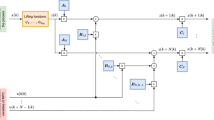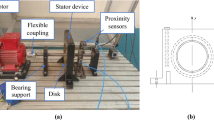Abstract
This work presents the development of a discrete parameter model consisting of a concentrated mass which is supported by a set of springs and dampers positioned in two orthogonal directions, such that the mass can move horizontally and vertically in a plane. A non-ideal motor is attached to the mass such that the phenomenon of resonance capture can occur. Resonance capture occurs in structures with low damping which are attached to rotating machines with limited power supply. When resonance capture occurs, the mean angular velocity of the motor remains constant and the displacement of the structure increases. An investigation on the influence of the two orthogonal resonance frequencies is presented. It was found that this model can illustrate the dynamics of a more complex structure consisting of a portal frame coupled to a non-ideal unbalanced motor. Experimental tests are used to support numerical simulations and the analytical model.





















Similar content being viewed by others
References
Balthazar JM, Mook DT, Weber HI, Brasil RM, Fenili A, Belato D, Felix J (2003) An overview on non-ideal vibrations. Meccanica 38(6):613–621
Bishop SR, Galvanetto U (1993) The behaviour of nonlinear oscillators subjected to ramped forcing. Meccanica 28(3):249–256
Dhondt G (2004) The finite element method for three-dimensional thermomechanical applications. Wiley Online Library
Felix JLP, Balthazar JM (2009) Comments on a nonlinear and nonideal electromechanical damping vibration absorber, sommerfeld effect and energy transfer. Nonlinear Dyn 55(1–2):1–11
Felix JLP, Balthazar JM, Brasil RM (2005) On saturation control of a non-ideal vibrating portal frame foundation type shear-building. J Vib Control 11(1):121–136
Geuzaine C, Remacle JF (2009) Gmsh: A 3-d finite element mesh generator with built-in pre-and post-processing facilities. Int J Numer Methods Eng 79(11):1309–1331
Gonçalves PJP, Silveira M, Pontes BR Jr, Balthazar JM (2014) The dynamic behavior of a cantilever beam coupled to a non-ideal unbalanced motor through numerical and experimental analysis. J Sound Vibration 333(20):5115–5129
Hairer E, Wanner G (1996) Solving ordinary differential equations II: stiff and differential-algebraic problems. Springer, Berlin
Kerschen G, McFarland DM, Kowtko JJ, Lee YS, Bergman LA, Vakakis AF (2007) Experimental demonstration of transient resonance capture in a system of two coupled oscillators with essential stiffness nonlinearity. J Sound Vib 299(4):822–838
Krasnopolskaya T (2006) Chaos in acoustic subspace raised by the sommerfeld-kononenko effect. Meccanica 41(3):299–310
Lee YS, Kerschen G, Vakakis AF, Panagopoulos P, Bergman L, McFarland DM (2005) Complicated dynamics of a linear oscillator with a light, essentially nonlinear attachment. Phys D: Nonlinear Phenom 204(1):41–69
Palacios J, Balthazar J, Brasil R (2002) On non-ideal and non-linear portal frame dynamics analysis using bogoliubov averaging method. J Braz Soc Mech Sci 24(4):257–265
Quinn D, Rand R, Bridge J (1995) The dynamics of resonant capture. Nonlinear Dyn 8:1–20
Quinn DD (1997) Resonance capture in a three degree-of-freedom mechanical system. Nonlinear Dyn 14(4):309–333
Sommerfeld A (1902) Beiträge zum dynamischen ausbau der festigkeitslehe. Physikal Zeitschr 3:266–286
Zniber A, Quinn DD (2006) Resonance capture in a damped three-degree-of-freedom system: experimental and analytical comparison. Int J Non-Linear Mech 41(10):1128–1142
Author information
Authors and Affiliations
Corresponding author
Appendix
Appendix
The equations of motion in terms of the uncoupled accelerations are given in Eqs. 17, 18 and 19.
in which,
1.1 Encoder
Figure 22 shows the optical sensor used to measure the angular velocity of the motor during the experimental tests.
Rights and permissions
About this article
Cite this article
Gonçalves, P.J.P., Silveira, M., Petrocino, E.A. et al. Double resonance capture of a two-degree-of-freedom oscillator coupled to a non-ideal motor. Meccanica 51, 2203–2214 (2016). https://doi.org/10.1007/s11012-015-0349-z
Received:
Accepted:
Published:
Issue Date:
DOI: https://doi.org/10.1007/s11012-015-0349-z





